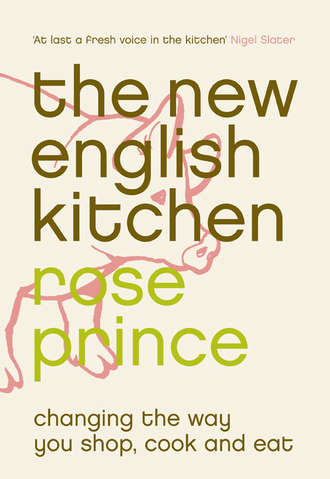
Полная версия
The New English Kitchen: Changing the Way You Shop, Cook and Eat
Serves 4–6
240g/8oz red lentils
1 onion, chopped
a pinch of ground turmeric
3 tablespoons vegetable oil
2 garlic cloves, chopped
2 hot green chillies, chopped
2cm/3/4 inch piece of fresh ginger, peeled and finely chopped
juice of 1 lime
2 kaffir lime leaves, slightly torn
240g/8oz feta cheese, broken into lumps
Put the lentils in a pan with the onion and turmeric, cover with water (or stock) and bring to the boil. Simmer for 45 minutes, then strain.
Heat the oil in a large frying pan, add the garlic, chillies and ginger and cook over a medium heat until singed light brown, but not burnt. Stir in the lentils, lime juice and lime leaves, then bring to the boil and add the cheese. Take to the table when very hot – the cheese will soften as it heats through.
beans
Beans are the pasta of Spain and the Latin American countries where they come from, but they do not share pasta’s convenience-food factor – unless bought in cans. Dried beans bought in the UK take a seeming age to cook and there is a reason for this. In countries where beans are really valued, they tend to be fresher even when dried, since they are taken from the new-season crops. Ageing beans, dry as can be and probably years old, are sent to those who care less about them – to, er, places like Britain, where everyone happily consumes chicken breasts and tiger prawns for their protein fix. So we get the old beans – the ones that take ages to cook. No wonder everyone prefers pasta. Chick peas are the worst – I once waited seven hours for a pan to produce a batch soft enough to eat. The energy cost must have run to the price of a rib of beef. You can buy better beans (there are specialist varieties in Spanish groceries), and patience – or a pressure cooker – will deliver nice tender beans eventually. It’s not that you have to do anything while they go through their eternal simmer, just that you have to be around – and most people would prefer to be doing something else.
It’s because of this that I am a fan of canned beans. I buy my haricots, cannellini, flageolet and black-eyed beans in cans. They still go a long way – averaging 30 pence per helping – and are perfectly cooked and ready to use. They keep for ever and, apart from being damned heavy to carry back from the shop, are a practically perfect food.
windowsill bean sprouts
Not the oriental sprouts but mung bean sprouts, left on damp paper. This is a lovely, crunchy little sprout that gives its liveliness to open sandwiches made with cold meat and mustard. Children can be put in charge of production – the biology lesson alone is healthy stuff.
Use an old wooden or plastic seed tray with drainage holes and put it on something leak proof. Cover with four layers of kitchen roll and dampen with water. Scatter mung beans on top and leave to germinate, moistening the paper again if necessary. When the sprouts are about 2cm/3/4 inch high, after about four days, they are ready to eat.
You can do the same with herb seeds, and slavishly follow the current fashion for pointless but fun infantile plantlings. Frankly, bigger leaves have far more oomph. But there’s no harm in them, and buying big packs of coriander seeds will produce coriander babies in a matter of days, to chuck on to green salads, open sandwiches and shut ones.
butter beans marinated with shallots and watercress
To eat with cold meat, such as ham, pork, chicken or beef.
Serves 4
6 shallots, sliced
6 tablespoons olive oil
2 cans of butter beans, drained
the leaves from 2 bunches of watercress (the stalks can be
reserved for soup)
sea salt and freshly ground black pepper
In a saucepan, stew the shallots in the oil for about 2 minutes to remove their raw aroma. Add the beans, remove from the heat and leave to steep in the shallot-flavoured oil until cold. Season to taste and add the watercress, stirring the salad well.
This salad will keep in the fridge for a week – the watercress will wilt but it will still taste lovely. Again, this goes against standard food-safety advice but I check it, smell it, and look for any bubbles or bad signs.
kitchen note
Add canned tuna to this recipe (see here).
baked chick peas, peppers and potatoes with yoghurt sauce
Another one-pot standard to keep in the fridge for busy weeks when you don’t want to cook. The yoghurt sauce will brighten it, and it’s good alone or as a side-of-the-plate number.
Serves 6–8
3 teaspoons ground cumin
1 teaspoon ground ginger
1 teaspoon freshly ground black pepper
1/2 teaspoon salt
4 tablespoons vegetable oil
2 onions, sliced
2 red peppers, cut into strips
2 cans of chick peas, drained
20 cherry tomatoes, or 6 small tomatoes, halved
2 sprigs of thyme
600ml/1 pint chicken, vegetable or beef stock
1 tablespoon butter
For the yoghurt sauce:
8 tablespoons plain yoghurt
1 tablespoon olive oil
a pinch of salt
1 teaspoon black onion seeds (nigella)
Preheat the oven to 200°C/400°F/Gas Mark 6. Mix the spices, pepper and salt together in a small bowl – you will need them as you layer the dish.
Heat the oil in a large casserole and add the onions and red peppers. Cook them over a medium heat until they soften, then add a layer of sliced potatoes and season with the spice mixture. Add a layer of chick peas with half the tomatoes and a sprig of thyme, then season again. Repeat the layering process, finishing with a layer of potatoes and using all the spice mixture. Pour over the stock, dot the surface with the butter and bake for 1 hour, or until the potatoes are tender. Leave for half an hour before you eat, to let the flavours merge.
For the sauce, combine the yoghurt with the olive oil and salt in a bowl. Scatter the black onion seeds on top and serve with the baked chick peas.
potatoes
Buying sacks of British potatoes at the roadside, even in cities, is a great economy. They should be sold in paper sacks to keep the light away from them and prevent them turning green. I now keep a metal dustbin outdoors for potatoes but as long as you store them in a cool, dark place they should be fine.
Looking at the supermarket shelves, you would think that only two or three potato varieties grow in the UK. It’s not that Maris Piper, King Edwards or Desiree are dull, simply that there are dozens of other varieties in danger of vanishing unless there is a demand for them – and we, the cooks, are missing out. Many of them are lovely, with colours ranging from white to yellow, and purple to a strange blue-black. Some are waxy, some are earthy and fibrous, some even taste of lemons or chestnuts. Seek out Kerrs Pink, Shetland Black, Wilja and Golden Wonder, as well as some interesting varieties of new potato (see the Shopping Guide). The types of potato grown in domestic gardens are more exciting still – these are the places where you will find old-fashioned varieties such as British Queen, Arran Pilot, Majestic, Suttons Foremost and the various Pentlands.
I would always choose British potatoes over imported but there is a window, between March and May, when supplies are low and the quality is frankly poor. I compromise by buying imports from Cyprus and Spain. I look out for organic when I can, as I do with British potatoes, for clear reasons:
organic potatoes
The season for organic potatoes in Britain is shorter than that for conventionally grown potatoes. The first organic new potatoes are dug in late April/early May and the first large, storable potatoes arrive in shops in September. The late arrival is due simply to the slower growth rate – conventional potatoes grow fast with the help of fertiliser and a lot of water. Using less water and allowing the potato to grow at a natural rate not only strengthens it, protecting it from disease, but it gives the potato more flavour. Here is an instance where there is no doubt at all that an organic food has more flavour than its conventional counterpart. Ordinary potatoes are routinely treated with anti-blight spray – their fast growth means weaker plants that need frequent treatment. They are also treated with sprout suppressants and insecticides after harvest. Organic farmers find that growing several types of potato throughout the season in soil that has been well nourished with manure will also help control disease, but they are allowed to spray with copper to prevent blight. Copper treatments are controversial, as residues remain in the soil, but still greatly preferable to the numerous chemical treatments used on conventional potato farms.
the price of potatoes
Potatoes are caught up in the supermarkets’ price wars – sold at less than their value in order to attract customers. Some poorly flavoured varieties are sold for just a few pence per kilo. The real price of the best conventionally farmed potatoes should in fact be up there with the price of organic potatoes, odd as it may seem. This is around £1.40 per kilo. With a kilo of potatoes yielding about five helpings, that’s 28 pence per helping – still a bargain for a high-quality food.
roast potatoes
Dripping or duck fat is ideal for making really crisp roast potatoes but you can get a good result with vegetable oil using the following method. I routinely sprinkle flour on to the potatoes after the par-boiling stage because it guarantees crispness, especially in summer when potatoes can be watery, but you can leave it out if you wish.
1 large, floury potato per person, plus a couple more for good measure
a little flour for sprinkling
dripping, duck fat or vegetable oil
About 11/4 hours before you are due to eat, peel the potatoes and cut them into a shape you like. I cut them lengthways into quarters for a sleek look. Put them in a large pan, cover with water and bring to the boil. Simmer for 5 minutes, then drain in a colander and leave them there to steam for a minute. Sprinkle with a light coating of flour and shake the potatoes around in the colander.
Heat some fat in a separate roasting tin or, if there is room, in the tin you are roasting your meat in. The fat should be about 5mm/1/4 inch deep. When it is hot, lift out each potato from the colander and place at even intervals in the tin. Place in the oven and roast until tender and browned – you will probably have to take them out of the oven and turn them over once.
more roast winter vegetables
About half an hour before you serve the roast, slice 1 sweet potato, cut 3 medium parsnips into quarters lengthways and peel a small squash – any sort – and cut it into slices 1cm/1/2 inch thick. Add them to the tin with the roast, or the roast potatoes, if there is room. Or heat some fat in a separate tin and roast for 25 minutes.
leftover roast potatoes
The season for large potatoes that will keep through the winter begins in August. Cooking too many potatoes is a habit of mine, probably brought about by greed. Before I had children, we always had lots of roast potatoes left over, and I used to fry them until crisp and eat with peppery or bitter greens such as rocket, watercress or curly endive. They become yet more colourful with the addition of diced red chilli and dabs of black olive tapenade.
unused potato skins
Leftover potato peelings that are clean and unblemished can be shallow-fried, preferably in dripping or groundnut oil, until crisp. Serve with soured cream and a chilli sauce.
roast potato soup
You need only a few leftover roast potatoes – or parsnips if you routinely add them to your roasts – to make a heartening soup for very cold weather.
Serves 4
6 roast potatoes or parsnips, cut into cubes
1 large onion, chopped
600ml/1 pint milk
600ml/1 pint chicken or beef stock
salt and freshly ground black pepper
Put the potatoes or parsnips, onion, milk and stock in a pan and bring to the boil. Simmer for about 20 minutes, then cool slightly and liquidise until very smooth. Reheat gently, season to taste, and serve in large bowls, with maybe some chopped fried bacon to make more of a meal of it.
mashed potato
This is easily the most useful of all types of cooked potato and, like rice, it keeps well in the fridge in a sealed container. If it begins to discolour, I throw it away immediately. Milk adds lightness to mash – and scalding it accentuates the potato flavour.
Makes about 10 helpings
2kg/41/2lb old potatoes, peeled
300ml/1/2 pint milk
60g/2oz butter
sea salt and freshly ground black pepper
Boil the potatoes in a large pan of salted water until soft (test by spearing a potato with a sharp knife and holding it just above the pan; if the potato falls off the knife after a second, it is ready – if it sticks, it is not). Drain in a colander and leave in the colander for 10 minutes to steam. The more liquid that leaves the potato, the better the mash. Some people put their (metal) colander of potatoes in a preheated oven for a few minutes, to be sure.
You can either mash the potatoes in the traditional way with a potato masher or purée them through a food mill (mouli-légumes). Then heat the milk to boiling point in a separate pan and beat it into the potato with the butter. Season to taste.
kitchen note
Peeling the potatoes before cooking is an old habit, and I know that boiling potatoes with the skin on works beautifully, too. Doing this means slipping off the potato skins when they are still hot. It’s up to you.
potato cakes with watercress sauce
Makes 8
1/2 quantity of mashed potato
2 eggs, beaten
flour for coating
sunflower or groundnut oil for shallow-frying
For the sauce:
1 bunch of watercress, finely chopped
150ml/1/4 pint crème fraîche
1 egg yolk
salt and freshly ground black pepper
Mix the mashed potato thoroughly with the eggs and return to the fridge to firm up. Form the mixture into little cakes, about 5cm/2 inches in diameter and 1cm/1/2 inch thick, and coat them in flour. Heat a thin layer of oil in a frying pan, add the potato cakes and shallow-fry over a medium heat for about 5 minutes on each side, until lightly browned.
Meanwhile, heat the watercress, crème-fraîche and egg yolk together in a small pan, whisking gently. Remove from the heat before it boils and season to taste. Serve the potato cakes with the sauce poured around the edge.
smoked trout potato cakes
Follow the above recipe, mixing 2 flaked fillets of hot-smoked trout into the mashed potato, together with 2 chopped hard-boiled eggs, if you like. These fishcakes are very good with the watercress sauce.
bubble and squeak
What more can be said about a classic leftovers hash? Except that I add egg yolks for richness, which is not authentic but very good. You can leave them out, if you prefer.
240g/8oz leftover cooked cabbage
1/2 quantity of mashed potato (see here)
2–4 leftover egg yolks
3 tablespoons dripping
Mix the cabbage, potato and egg yolks together. Heat the dripping in a large frying pan, add the potato mixture and fry over a medium-low heat on both sides, until it forms a crisp cake that is hot all the way through.
kitchen note
You can use the same method with all the brassica family, whether the much-maligned Brussels sprout or the ultra-chic Italian cavolo nero. You can also use cooked leeks, anything from the squash family, or sweetcorn – a hash is a hash.
salad potatoes
Salad potatoes are small with firm skins. They are available all year round, and while it is always the right move to buy British during our own new-potato season – from April to July – imported types can be fine when there are no home-grown to be had. Varieties omnipresent in supermarkets are Charlotte and Nicola but do seek out the rarer breeds, too. These include La Ratte, Pink Fir Apple, Belle de Fontenay, Duke of York and Kestrel (see the Shopping Guide). Organic salad potatoes are grown slowly, a factor that no doubt accounts for their deeper flavour. Cook more than you need and use them to help other meals happen. Don’t confuse year-round salad potatoes with specialist seasonal types like the papery-skinned Jersey Royals, which begin to arrive in Britain as early as February, or their Cornish early equivalent.
potato salad
This is the best salad to eat with cold ham or beef. The sweeter the onions, the better it will taste. If you can find Breton or Roscoff onions – they are still sold in strings – so much the better. So-called banana shallots, which are in fact onions, make a good substitute.
Serves 4
1kg/21/4lb salad potatoes
1 teaspoon salt
6 shallots, or pink Roscoff onions if you can find them, sliced
Mayonnaise (see here)
Put the potatoes in a pan, cover with water and add the salt. Bring to the boil and cook until just tender – they should still be waxy in the centre when you cut them open. Drain and leave to cool, then slice thickly. Put them in a bowl and add the shallots and enough mayonnaise to coat. Mix well.
the freezer
Before you run screaming from the room, I am not about to make you cook for the freezer. I do freeze extra food, but not great bags of every type of vegetable and fruit, which only become soggy and tasteless when defrosted. I make a few shepherd’s and fish pies, and braised meat stews and sauces to store in the freezer. Otherwise I prefer to cook from stored ingredients. However, there are foods that are ideal for freezing: peas, broad beans and spinach come to mind. Sweetcorn freezes well – so much better for the children than canned – as do all red berries apart from strawberries.
broad beans
Frozen broad beans have to be used in a certain way because one of their weakest points serves them very well in the freezer. The pale skin that surrounds the inner, podded bean toughens unpleasantly but in doing so protects the flesh of the bean from the ice crystals that make most frozen vegetables go soggy. Broad beans are inexpensive, so the method that follows is not as wasteful as it seems.
Defrost the beans in a colander and put them in a pan. Pour over boiling water and reheat to boiling point. Drain, splash with plenty of cold water and then pinch off the pale skin of each bean. It doesn’t take long and you are left with beautiful bright green kernels, perfect to dress with oil and lemon juice and eat with dry-cured meat, hard-boiled eggs, soft goat’s cheese, or even quite alone.
frozen peas
A terrific vegetable, and ingredient. It is true that frozen peas often taste better than fresh, unless you can be sure that your fresh supply has been picked within two or three days. This is because fresh peas deteriorate quickly, becoming hard and starchy. It is now possible to buy organic frozen peas and petits pois. I recommend them. not least because it is an inexpensive way to eat naturally produced food (see the Shopping Guide).
Blend frozen peas with stock for an almost-instant pea soup, stir them into rice dishes, or combine them with skinned broad beans (see above), spinach, olive oil and fresh mint for a simple salad that will put the colour green into your winter food.
pea soup with potatoes and bacon
Serves 4
1 litre/13/4 pints chicken, beef or vegetable stock
2 spring onions, chopped
480g/1lb frozen peas, defrosted
150ml/1/4 pint single cream or whole milk
4 rashers of unsmoked back bacon, cut into thin slivers
8 salad potatoes, boiled in their skins until just tender then
thickly sliced
leaves from 4 sprigs of dill
sea salt and white pepper
Heat the stock to boiling point and add the spring onions and peas. Bring back to the boil and simmer for 1 minute. Allow to cool for a few minutes, then liquidise with the cream or milk. Season to taste with salt and pepper.
Fry the bacon over a low heat until crisp, then add the potatoes and stir to warm them through. Serve the soup in deep bowls with a large spoonful of bacon and potatoes in each. Scatter the dill on top.
frozen spinach
Defrosted slowly, frozen spinach can be as good as fresh. All the water must be squeezed out, and the spinach cooked either with plenty of butter, or heated with good olive oil to make this quick vegetable dish.
spinach with pine nuts
Serves 2
2 tablespoons pine nuts
480g/1lb frozen whole-leaf spinach, defrosted and the water
squeezed out
2 tablespoons olive oil
1 tablespoon lemon juice
salt and freshly ground black pepper
Dry-toast the pine nuts in a frying pan until lightly browned, then set them aside in a bowl. Warm the spinach through in a pan and add the oil. Transfer to a dish, season with salt and freshly ground black pepper and scatter the pine nuts on top. Finish with the lemon juice.
canned food
Canning is ideal for certain foods, a good and pure way to store them without preservatives. It can even improve them in some cases – skipjack tuna being an example.
skipjack tuna
I could never understand why anyone would want to eat a lot of seared fresh tuna. Half the time it is dry and tasteless and, when buying it, it can be hard to tell how long it has been out of the water. What’s more, at the current rate of consumption, blue and yellow fin tuna will soon go the way of the dodo. Blue fin – the type favoured by the Japanese for top-quality sushi – is at an all-time low, while yellow fin is in serious decline. The only tuna not listed as endangered is skipjack. The standard of canned skipjack tuna varies from dubious and disgusting small flakes that look like factory-floor sweepings in unidentifiable oil, to tender fillets that, when packed in the tin, look like the cross section of an old tree trunk. This tuna is far superior and has a light texture, because it does not absorb too much oil. The unique double-cooking technique – before canning and then again when the sealed cans are heated to preserve the contents – seems to improve and tenderise the flesh. It can then simply be softly flaked into a salad or sandwich, or made into a delicately flavoured fish cake.







